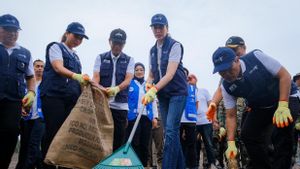JAKARTA Cases of hand disease, foot, and mouth disease (HFMD) or more popularly known as Singapore flu are soaring in Indonesia. Ahead of the trend of Eid homecoming, the risk of transmission of this disease must also be watched out for by the public.
According to Data from the Early Alert System and Response of the Ministry of Health, until the 11th week of 2024 there were at least 5,461 cases of Singapore flu in Indonesia. Meanwhile, from several reports from health offices in the regions, 738 cases were reported in Banten and 45 cases in Depok.
The increasing number of HFMD diseases in the midst of preparations for the Eid Al-Fitr 1445 holiday encourages the public to be more vigilant. Self-awareness to adopt healthy and clean life, including wearing masks, is a step to prevent disease transmission such as Singapore flu, although this is not a serious disease.
"Anticipate during Lebaran homecoming, because this is indeed Indonesia's annual tradition, it is never quiet. This is an annual migration. Of course, it invites the risk of spreading infectious diseases, we hope that both Singapore's flu, whether COVID-19, does not increase during homecoming," said a member of the PB IDI Infectious Disease Management Study (Indonesian Doctors Association) Prof Dr Dr Dr Dr. Erlina Burhan, MSc, SpP(K).
National Police Chief General Listyo Sigit Prabowo appealed to people who will return to their hometowns to arrange their departure schedule to avoid the peak of the 2024 Eid homecoming flow. The peak of the homecoming flow is predicted to occur in the period Friday 5 April to Sunday 7 April.
"You can take advantage of your time and set times to avoid the peaks of the homecoming flow. Usually, it is possible to carry out night activities, this can shift to noon," he said in a written statement, Tuesday (2/4).
In the midst of high mobility during Eid homecoming, people are still asked to be aware of the risk of disease transmission, one of which is by implementing a healthy lifestyle. Infectious diseases such as COVID-19 and HFMD are said to be stalking travelers this year. That's why various efforts have been made, including maintaining the body's immunity, so that there is no spike in cases after the homecoming period is over.
Regarding the possibility of an increase in cases of infectious diseases during Eid homecoming, Erlina suggested that travelers always maintain cleanliness, such as washing hands with soap or hand sanitizer to prevent disease transmission during homecoming. In addition, the use of masks in crowded places can also help prevent transmission of HFMD disease.
Lebaran homecoming is usually filled with moments of gathering with family and taking a vacation to a number of tourist attractions, such as beaches, swimming pools, or rivers. When swimming, Erlina suggested choosing a clean pool and disinfecting toilets and objects that are within the reach of children.
This must be considered when traveling to homecoming, both on trips and homecoming destinations.
The worse the sanitation, the higher the level of contamination and the rate of infection. So, it is very important to pay attention to the clean behavior of healthy living, including during homecoming. It's not only to prevent Singapore flu, but also other infectious diseases," Erlina said.
Hand disease, foot, and mouth disease (HMFD) may still sound foreign to the public, who are better familiar with the Singapore flu. In fact, according to a pediatrician who graduated from Gadjah Mada University, Prof. Dr. dr. Edi Hartoyo, Sp.A(K) the mention of Singapore flu disease is a miskrah. Doctor Edi said that this HFMD disease has actually been in Toronto, Canada since 1957.
"This term (Singapore flu) is wrong, because it came from not Singapore. It's just that in 2000 and 2006 many of these cases were there and some died, so they became famous as Singapore flu, even though they were not from Singapore," said dr. Edi in an online seminar held by PB IDAI, Tuesday (2/4/2024).
On that occasion, Edi explained, the causes of HFMD are entertainmentvirus, including the coxsackievirus A16, EV 71, and echovirus.
"Definition of HFMD sufferers is a collection of symptoms of red skin lesions, especially in the palms of the hands, feet, and mouth which are caused by viruses and many babies and toddlers aged less than five years," said Edi.
HFMD transmission is almost the same as COVID-19, namely through contact with a patient or droplet. Transmission can occur directly, for example because of cough, sneezing, exposed to saliva and from dirt or feces.
In addition, indirect contact transmission can also occur because the use of objects used by children experiencing HMFD, such as towels, toys or eating utensils. Thus, it can be said that HFMD is very easily transmitted either directly or indirectly, especially in children.
Even though they are both infectious diseases, HFMD is not included in the group of dangerous diseases. Children affected by HFMD only need adequate rest, isolating so as to prevent transmission to other children.
SEE ALSO:
"The Singapore flu is indeed an infectious disease, but it is not a serious disease. The important thing is to get enough rest, eat nutritious food, drink enough water to prevent dehydration," said Edi.
"There is no specific cure for this disease. With a good body condition, it will heal itself," he concluded.
The English, Chinese, Japanese, Arabic, and French versions are automatically generated by the AI. So there may still be inaccuracies in translating, please always see Indonesian as our main language. (system supported by DigitalSiber.id)














